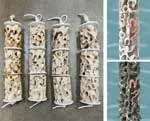珊瑚碳酸盐
2021-11-12AlexSchofield
设计:Alex Schofield

珊瑚碳酸盐:建筑环境之外的建筑
如今,我们的生存足迹已对全球生态系统产生了灾难性影响。受到人为条件破坏,珊瑚礁正大面积地消失,速度已超过了它们恢复和生长的速度。该项目展示了3D 打印碳酸钙珊瑚基质的新应用,一旦嵌入能够对水生生态系统进行针对性的干预和人工恢复。更具体地说,3D 打印的碳酸钙基质可代替构成活体珊瑚虫的坚硬家园。这种独特材料的开发促进材料方法学制造并补入了3DP 碳酸钙脚手架以支持更广泛的海洋生物生态系统。3DP 碳酸钙目前正在进行结构、拼贴和碎片测试用于进一步作为活体修复人工珊瑚,同时展现了生物基质协助其他海洋生物生长的前景。修复人为原因造成的物理破坏,重建健康和具有生物多样性的水生生态系统是干预的最终目标。
该项目不仅仅植入和补充了珊瑚生长基质,还建立了人工建筑环境与周围自然生态系统之间的联系。现在,我们思虑建筑之外的世界边界,将曾经坚硬的海岸线与水体边界摩挲的更加柔软。本项目帮助海岸线基础设施建设、生物修复基质与建筑表面,促进水生生物的生长。
混凝土和其他陆地建筑材料等替代材料在用于水下制造时会因自身生产过程浸出不良副产品,并造成大量碳排量。捕获和封存碳的新技术,本质上是从环境中清除有害的二氧化碳,不仅能够减少日益增长的二氧化碳污染,也可以创造碳酸钙的可再生来源。将设计和材料创新与快速和可定制的3D 打印技术前景相结合,可以在独特环境中灵活部署,保护海洋生物。
项目的初衷和发明都为直接解决世界危机。人类目中无人地生活着,难以想象会给世界带来怎样颠覆的变化和影响。项目从人类和水生生物需求的角度出发,在建筑环境很少考虑的空间里发挥着重要作用。作为陆地上的哺乳动物仍然能够对我们可能从未访问或看到的生态系统产生巨大影响。因此,我们设计和建造建筑环境必须平等于地球上所有生命体。该项目精密的计算设计和碳酸钙材料制造极大程度上方便了人为建筑环境融入自然共生系统。
Coral Carbonate:Architecture Beyond the Built Environment
The footprint of our existence has had catastrophic impacts on ecosystems globally.In particular,coral reefs are being decimated by human-induced conditions quicker than they can recover and grow.This project exhibits novel application of a 3D printed coral substrate,in form of the material substrate Calcium Carbonate,as targeted intervention and artificial restoration for aquatic ecosystems.More specifically,Calcium Carbonate is 3D printed to mimic materiality which makes up the hard structural home of coral’s living polyp inhabitants.This unique material development has led to the invention of material methodology in support of a wide range of ocean life ecosystems by fabricating and reseeding a 3DP calcium carbonate scaffold.The 3DP calcium carbonate is currently being tested as structures,tiles,and frags used to further test live applications in support of artificial coral restoration,but also shows promise as a biological substrate for the growth of other ocean life.The ultimate goal of such an intervention is the cultivation of a healthy and biodiverse aquatic ecosystem through adaptation and repair of physically damaged environments caused by anthropogenic sources.
This project and application goes beyond simply a substrate to seed and supplement the growth of coral,but creates a link between our anthropocentric built environment and surrounding natural ecosystems.What once was a hard edge,being our coastlines and interface with water bodies,is now being explored as a softer edge as we reconsider our interface between the world beyond buildings.This project has applications in coastline infrastructure,aquaculture,and bioremediation as substrate and surface to foster growth of aquatic organisms.
Alternative materials for underwater fabrication,such as concrete and other land based materials of the built environment,often leach undesirable byproducts and contribute a large carbon footprint in the process of their own production.However,new techniques of Carbon capture and sequestration from our atmosphere,essentially removing harmful CO2 from our environment,can also create a renewable source of Calcium Carbonate while helping diminish our growing CO2 pollution.By combining design and material innovation with the rapid and customizable fabrication potential of 3D printing,this unique application for ocean life conservation can be readily deployed at various scales in any unique environment.
This project’s origins and inventions come in direct response to a world in crisis.We are seeing the world change in such a way as reflected from our modus operandi as humans who have little considered our impacts.This project most importantly operates at the intersection of both human and aquatic needs,a space seldom considered within construction of the built environment.While we may be land dwelling mammals,we still have great impact on ecosystems we may never visit or see and thus we must consider our intentional design and construction of a built environment that is equitable to all living organisms on this planet.This project’s methodologies of computational design and fabrication utilizing CaCO3 provide various benefits for a shift from an anthropocentric built environment to that of a symbiotic one.





